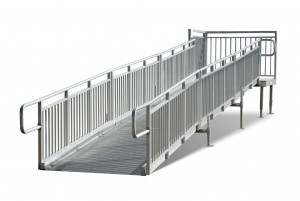Ever since the Americans With Disabilities Act (ADA) became law in the early 1990s, public building accessibility ramps have been a major priority for those who own or manage structures used by the general public. REDD Team has made sure our clients are completely ADA compliant for more than 25 years, and we’ll be happy to do the same thing for you. Whether you have a permanent building or a temporary, modular structure, we have the products you need to ensure everyone who wishes to enter can do so easily and safely.
Why Choose REDD Team?
 REDD Team is the premier provider of aluminum access products. Customers have used our stairs, ramps, platforms and walkways in a variety of different ways. Religious organizations, school districts, governmental agencies and retail businesses are just some of the customers we’re proud to have helped with their accessibility needs.
REDD Team is the premier provider of aluminum access products. Customers have used our stairs, ramps, platforms and walkways in a variety of different ways. Religious organizations, school districts, governmental agencies and retail businesses are just some of the customers we’re proud to have helped with their accessibility needs.
One of the reasons so many clients choose REDD Team is that we are experts in ADA compliance. We know how important it is to meet stringent ADA regulations – failure to do so can result in expensive legal action that can take years to resolve. We will take that risk out of the equation, because we’ll make sure your facility is completely accessible to anyone with mobility challenges.
How to Make Sure Your Ramps are Compliant With ADA Requirements
In order to conform to ADA requirements, ramps have to meet certain specific rules. Not every provider of accessibility systems is as familiar with the ADA as REDD Team. These are just a few of the considerations you’ll need to keep in mind if you want your ramps to be ADA-compliant.
- Handrails – Ramps with more than a six-inch rise have to be outfitted on both sides with handrails. These handrails must extend at least one foot from the end of the ramp, and have to be from 34-38 inches in height. The handrails have to be sturdy as well. They can’t rotate in your hand when you use them.
- Dimensions – The slope of a ramp can’t be any steeper than 1:12, meaning that it can’t rise more than one unit per 12 units of horizontal travel. This will provide the most access to the highest number of users. There are, however, certain situations where exceptions are made. These will typically include older buildings that have space constraints. Ramps cannot rise more than 30 inches, and must be at least 36 inches wide in most instances.
- Landings – The landings at the top and bottom of each ramp must be level. If a ramp is to be used in damp environments, they must not accumulate water. Aluminum ramps meet this requirement perfectly, because they drain much more efficiently than those made of wood or steel.
Did any of this come as a surprise? Have you not given a lot of thought to ADA specifications? If you can answer “yes” to either question, you need to get in touch with us as soon as you can. We’ll make sure your accessibility system is completely compliant with ADA requirements.
Contact REDD Team today if you would like more information on our public building accessibility ramps. You can contact us using our convenient form or give us a call at (800) 648-3696. We look forward to hearing from you.
